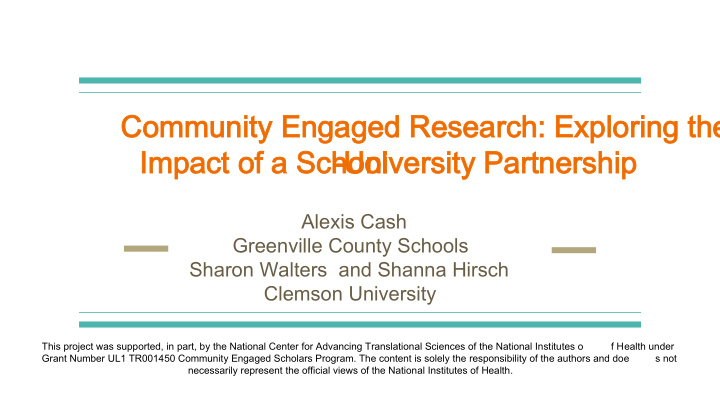



Community Engaged Research: Exploring the Community Engaged Research: Exploring the Impact of a School Impact of a School -University Partnership University Partnership Alexis Cash Greenville County Schools Sharon Walters and Shanna Hirsch Clemson University This project was supported, in part, by the National Center for Advancing Translational Sciences of the National Institutes o f Health under Grant Number UL1 TR001450 Community Engaged Scholars Program. The content is solely the responsibility of the authors and doe s not necessarily represent the official views of the National Institutes of Health.
Agenda Agenda School School -University Partnerships University Partnerships Overview of School District Overview of School District Development and Tenants of the Partnership Development and Tenants of the Partnership Summer Study Summer Study Benefits for Both Benefits for Both
Background and Introduction Background and Introduction School-University Partnerships: Proven to be reliable in: Unfortunately can create: Contemporary research ● Accomplishing specific tasks ● Unequal power dynamics suggests: ● Implementing new programs where universities benefit ● School-university ● Addressing PD needs more than partnering partnerships be ● Strengthening school- schools (Darling-Hammond, conceptualized with ‘third 1994; Walsch & Backe, 2013). university relationships for space’ ideology so future partnerships (Wepner, success of one partner is 2014). vital to success of the other (Zeichner, 2010; Walsch and Backe, 2013).
Community Engaged Partnership Community Engaged Partnership “the process of working collaboratively with and through groups of people affiliated by geographic proximity, special interest, or similar situations to address issues affecting the well - being of those people” (Centers for Disease Control and Prevention [CDC], 1997, p 9)
District and Partnership Information District and Partnership Information
11, 507 Students Receive Special Education Services
https://research.musc.edu/resources/sctr/programs/community-engagement/engaged-scholars
PARTNERSHIP PARTNERSHIP
Initial Aims Initial Aims Aim 2. Aim 2. Evaluate the Aim 1. Aim 1. Evaluate a PD series effectiveness of information for all self -contained SETs sessions to other stakeholders interested in learning more (i.e., administrators, family about classroom management members) to foster a strategies. continuum of support across settings (i.e., school, home).
RESEARCH STUDY RESEARCH STUDY Phase I During the first phase, all teachers will attend an intensive PD prior to the school year beginning. Summer PD We will complete a pre -test-posttest design to evaluate group performance on knowledge and efficacy. The second phase will occur during the school year. Phase II Across phase II we will determine the potential for Project CHAMPION to (a) change teachers’ classroom management knowledge and practices, (b) determ Follow -up collateral effects on students with disabilities, and (c) measure teachers’ self - efficacy and burnout. Coaching with CT- SCAN
Aims Changed Aims Changed Aim 2. Aim 2. Evaluate the Aim 1. Aim 1. Evaluate a PD series effectiveness of information for all self -contained SETs sessions to other stakeholders interested in learning more (i.e., administrators, family about classroom management members) to foster a strategies. continuum of support across settings (i.e., school, home).
Project Cham pion “One Team , One Goal” This project was supported, in part, by the National Center for Advancing Translational Sciences of the National Institutes o f Health under Grant Number UL1 TR001450 Community Engaged Scholars Program. The content is solely the responsibility of the authors and does not necessarily represent the official views of the National Institutes of Health.
Preliminary Results Preliminary Results
Reality of a School Reality of a School -University Partnership University Partnership ● Co-PIs on the Grant = Multiple Stakeholders ○ Pros: Many hands makes light work ○ Cons: Many hands - Different priorities (research vs. decor) ● Priorities Changed - Content did not match the original dependent variable (measure) ● Constant communication is necessary ● District - Better read of the room ● Budget
Benefits Benefits District District University University Consistency across the district Invested collaborators Leverage Resources - Access to schools (research, evaluation, evidence -based preservice teachers) practices Socially valid research questions Building a pipeline from higher education to the classroom District Co -PI Guest Lectures at Multiple stakeholders echoing Clemson the same message
Next Steps Next Steps Run analysis on Phase II observations Seeking additional foundation funding Spring boarding into other projects Expansion across the district Reignite the partnership with Clemson
Contact Information Contact Information Alexis Cash: aacash@greenville.k12.sc.us Sharon Walters: Swalte4@g.clemson.edu Shanna Hirsch ShannaH@g.clemson.edu
Recommend
More recommend